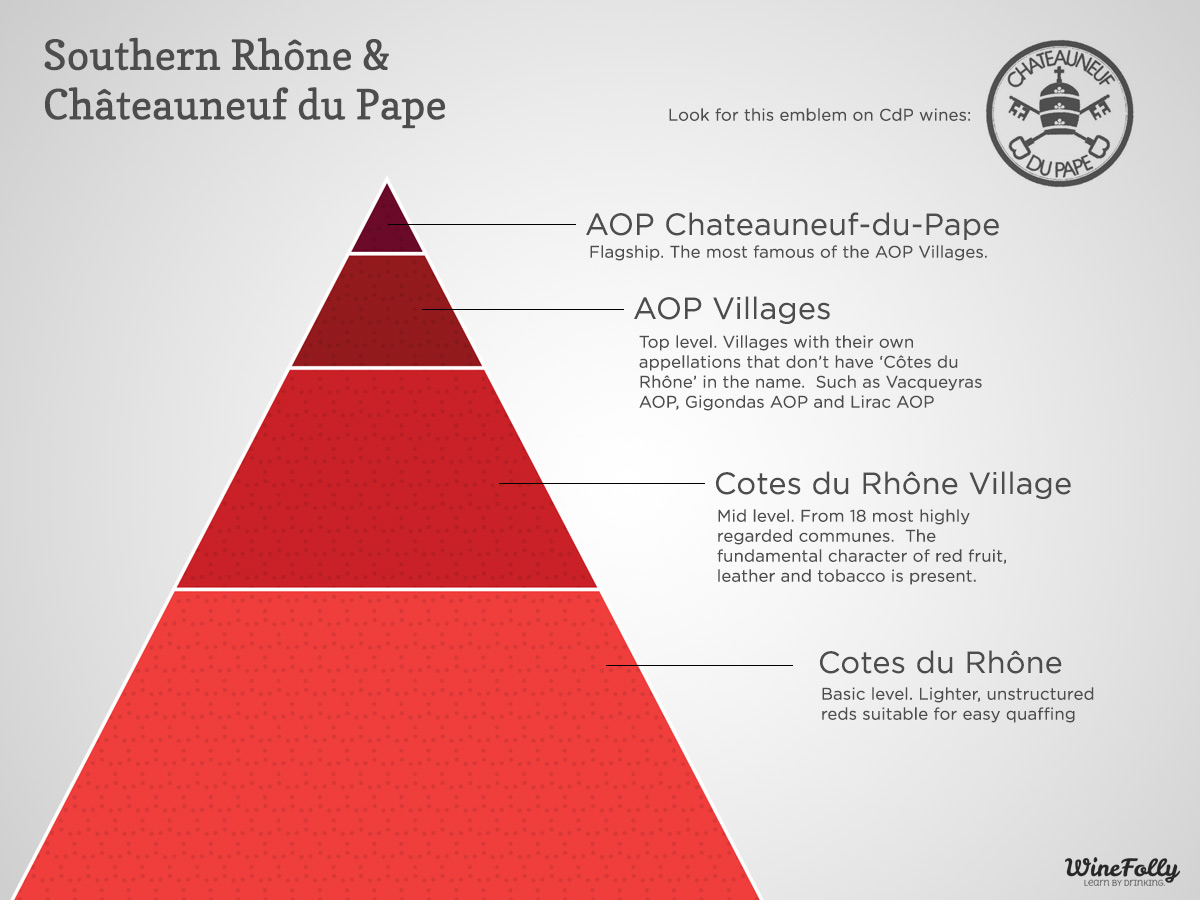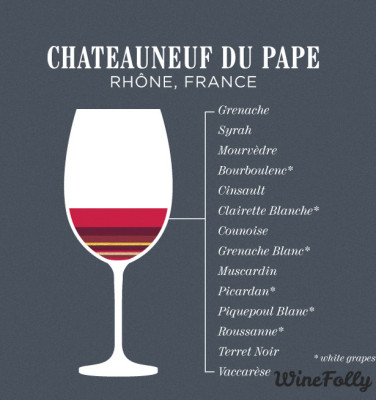All about Châteauneuf-du-Pape wine: the blend, the taste, and how to find great wines and awesome values from the Southern Rhône region.
Châteauneuf-du-Pape is worthy: the name comes from a fascinating period in Catholic history (when the Pope moved from Rome to Avignon ), it’s been name-dropped by the Beastie Boys (Mike D!), and it’s freaking delicious. Yet, it’s not cheap. A combination of reputation, limited supply, and some expensive techniques means that even the most basic Châteauneuf-du-Pape wines will cost you upwards of $30 (and over $100 for the good stuff). Fortunately, there are a number of similar wines around the area (the Southern Rhône) that offer comparable flavor and complexity at a fraction of the cost. Onward!
Taste of Châteauneuf-du-Pape
- Fruit Raspberry, Black Currant, Blueberry, Strawberry
- Earth/Other Leather, Dust, Violet, Thyme
- Oak Flavors Smoke, Tobacco, Cedar, Clove, Vanilla, Toast
Châteauneuf-du-Pape wines tend to have slightly higher alcohol at 14% ABV. The appellation permits just a touch of residual sugar (RS), which adds body to the taste. Because Châteauneuf-du-Pape has moderately high acidity, you usually can’t taste any sweetness.
The first thing to realize about the Southern Rhône is that virtually all the wines made there are blends. Grenache is the most widely planted grape, followed by Mourvèdre, Syrah, and Cinsault. While single-varietal wines can be found, the vast majority follow the GSM (Grenache/Syrah/Mourvèdre) template. It’s a natural pairing, since Grenache is vigorous and flavorful, but also thin-skinned and lacking pigment. Hence, the darker, more powerful Mourvèdre and the fruitier Syrah are blended together to achieve a more complex, enjoyable wine.

The Southern Rhône is hot. We’re talking long, hot summer days, with only Le Mistral (the summer wind) whipping in off the Mediterranean to keep things from getting too cooked. As a result, you get a lot of ripe, developed flavor in the wines of the area, and also relatively high alcohol levels. So if you like big, burly Aussie Shiraz, the Rhône is another place to look. Yet the better wines from the region have a savory, smoked meat quality that places them firmly in the Old World.
Finding Value in the Southern Rhône

Understanding the hierarchy of the Southern Rhône wines is essential for finding quality at a good price.
Basic Level: The most basic designation for wine from the region is Côtes du Rhône, and the grapes can come from anywhere within a very large region. Sometimes great values can be found, but most base-level Côtes du Rhône are lighter, unstructured reds suitable for easy quaffing and little else.
Mid Level: Moving up the level a bit brings us to Côtes du Rhône-Villages wines. These wines originate within one of the 18 most highly regarded communes within the Southern Rhône, and winemakers there can append the “Villages” tag to their labels, as well as the name of the specific village.
Top Level: Occasionally, a specific village will be judged to produce wines of such a high quality that they are elevated to their own AOP (the top tier of French wine classification). This happened with two separate Southern Rhône villages, and they’re the source of the best combination of value and quality in the area. Vacqueyras and Gigondas are both neighbors of Châteauneuf-du-Pape, and both offer similar wines at a much more approachable price point. Like their famous cousin, they pack tons of flavor, body, and structure into a package that starts with lush black and red fruits, mouthwatering savory aromas of cured meats, herbs like sage and rosemary, and even green olives. Silky on the palate, these wines finish with a hint of dusty red earth and a bit of acidity.
Want to geek out on the Côtes du Rhône region? Read this article
What Vintage Should I Buy?
Vintages in the Southern Rhône matter less than in many other French regions: it’s warm down there by the French Riviera, so it’s a rare vintage where grapes don’t reach full ripeness. That said, 2005, 2007, and 2010 are particularly strong recent vintages, with 2009 also being quite good.
CELLARING TIP: Generally Southern Rhône wines should be drunk within 5-10 years of their vintage, as only the finer Châteauneuf-du-Papes have aging potential much beyond a decade.
So where are all these villages you speak of? Check out the map below!
Southern Rhône Map
Don’t Fear the Funk
The wines of the Southern Rhône have a (justifiable) reputation for…well…funkiness. If you like that sort of thing, you might call it “gamey,” or “barnyard.” If you don’t, well then it’s more “horse butt” or “manure.” In either case, those aromas are the product of a yeast (Brettanomyces) that’s ambient in most wineries in the region. Some people like the added complexity that it seems to give to wines, and others find it disgusting. Different wines will have lower or higher levels of “Brett,” as it’s commonly referred to, and if the wine is allowed to sit open for an hour or so, most of the strongest aromas will dissipate, but it’s something to know about Southern Rhône wines.
Exploring Further
The much larger area surrounding the Southern Rhône grows the same grapes and makes similar blends. In particular, check out the wines of Bandol near Provence, and Corbières and Minervois in the Languedoc-Roussillon.
By the way, you can read more about the Rhône, including the Northern Rhône.
Zachary Geballe is a writer for Seattle Weekly and offers wine learning on vinetrainings.com


